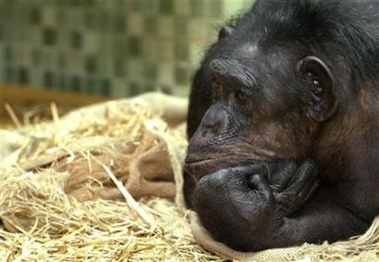WASHINGTON - Twenty-five years after the first AIDS cases emerged, scientists
have confirmed that the HIV virus plaguing humans really did originate in wild
chimpanzees, in a corner of Cameroon.
Solving the mystery of HIV's ancestry was dirty work. Scientists employed
trackers to plunge through dense jungle and collect the fresh feces of wild apes
¡ª more than 1,300 samples in all.

A chimp rests in his cage in a Berlin zoo.
Researchers who picked up and analyzed wild chimp droppings said on
Thursday they had shown how the AIDS virus originated in wild apes in
Cameroon and then spread in humans across Africa and eventually the world.
[Reuters] |
Before that, it took seven years of research just to develop the testing
methods to genetically trace the primate version of the virus in living wild
chimps without hurting the endangered species.
Until now, "no one was able to look. No one had the tools," said Dr. Beatrice
Hahn of the University of Alabama at Birmingham. She led the team of
international researchers that reported the success in Friday's edition of the
journal Science.
"We're 25 years into this pandemic," Hahn said. "We don't have a cure. We
don't have a vaccine. But we know where it came from. At least we can make a
check mark on one of those."
Scientists long have known that nonhuman primates carry their own version of
the AIDS virus, called SIV or simian immunodeficiency virus. But with one
exception, it had been found only in captive chimpanzees, particularly a
subspecies that in the wild populates mostly West Africa.
It was not known how prevalent the virus was in chimps in the wild, or how
genetically or geographically diverse it was, complicating efforts to pin down
the jump from animal to man.
Hahn's team tested chimp feces for SIV antibodies, finding them in a
subspecies called Pan troglodytes troglodytes in southern Cameroon.
Chimps tend to form geographically distinct communities. By genetically
analyzing the feces, researchers could trace individual infected chimps. The
team found some chimp communities with infection rates as high as 35 percent,
while others had no infection at all.
Every single infected chimp had a common base genetic pattern that indicated
a common ancestor, Hahn said.
There are three types of HIV-1, the strain of the human virus responsible for
most of the worldwide epidemic. Genetic analysis let Hahn identify chimp
communities near Cameroon's Sanaga River whose viral strains are most closely
related to the most common of those HIV-1 subtypes.
"The genetic similarity was striking," Hahn said.
The first human known to be infected with HIV was a man from Kinshasa in the
nearby country of Congo who had his blood stored in 1959 as part of a medical
study, decades before scientists knew the AIDS virus existed.
Presumably, someone in rural Cameroon was bitten by a chimp or was cut while
butchering one and became infected with the ape virus. That person passed it to
someone else.
The Sanaga River long has been a commercial waterway, for transporting
hardwood, ivory and other items to more urban areas. Eventually, someone
infected made it to Kinshasa.
"How many different transmission events occurred between that initial hunter
and this virus making it to Kinshasa, I don't know. It could have been one, it
could have been 10, it could have been 100," Hahn said. "Eventually, it ended up
in an urban area, and that's where it really got going."
Somewhere in all that spread, the virus became more deadly to people than it
is to chimps, who seldom are bothered much by SIV.
The research seems to settle any question of HIV's origin, said Dr. Anthony
Fauci, the National Institutes of Health's AIDS chief.
When tracing a virus' evolution, "it's important to get as close to the
source as you can," he said. "It's of historic interest."